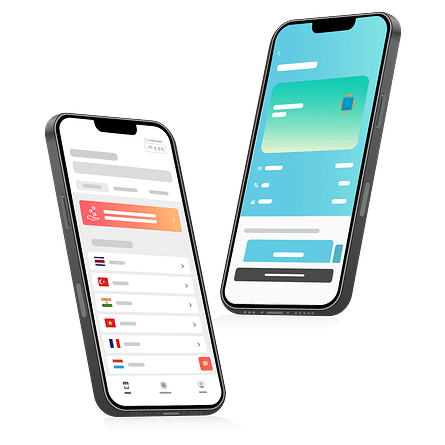
Whether using your mobile device for work, fun, or (let’s be honest) some combination of both, having a strong signal is essential.
As they gain popularity, people are asking more questions about whether eSIMs have better signal strength than their traditional SIM card counterparts. And with good reason — no one wants to be stuck with zero bars trying to use their device.
Let's look at the factors that can impact signal strength and network coverage in an eSIM and compare them with those that impact physical SIM cards.
In this article:
- What is an eSIM?
- Getting technical: How does an eSIM work?
- eSIM vs. physical SIM signal strength: Which is more powerful?
- What role does a network provider play in signal strength?
- Should you travel with an eSIM or SIM?
- eSIM vs. SIM FAQs
What is an eSIM?
An embedded SIM card (eSIM) is a digital form of the physical SIM card that lets you activate a cellular plan through software already embedded in your device. That means there's no need for a physical SIM to change your wireless carrier, data, or service plan with an eSIM. It's programmable remotely via software and is built into most new smartphones, so you don't have to buy a new physical SIM when switching phones or wireless carriers.
Getting Technical: How Does an eSIM Work?
On the surface, eSIMs and physical SIMs are nearly identical. The main difference is that you can remove a physical SIM. At the same time, eSIMs are reprogrammable chips embedded into the device's motherboard, so no physical swapping is required when you want to change carriers or plans.
All you need to do to change your SIM is head online, purchase and download an eSIM data plan, and you'll be ready to connect to a mobile network.
eSIMs can also store multiple profiles. For example, carrying a travel SIM with you is unnecessary if you're traveling. You can download and save a travel eSIM to your phone and activate it when needed.
eSIM vs. Physical SIM Signal Strength: Which is More Powerful?
Now that you know what an eSIM is, it's time to dive into signal strength — because no one wants to deal with zero bars even on their best days. When we talk about signal strength, multiple factors play into receiving a good signal. Let's dig into a few of those factors and explore how eSIM signal strength compares to traditional SIM cards.
What are the Factors that Affect Signal Strength?
Various factors impacting signal strength apply to both traditional SIM cards and eSIMs. Distance from the cell tower, obstructions, interference, and the device's antenna quality can all be the difference between the loading circle of death or viewing the latest TikTok, regardless of what kind of SIM you're using.
For both traditional SIM cards and eSIMs, the closer a device is to a cell tower, the stronger the signal will be. Obstructions like tall buildings, forests, or other dense vegetation can impact signal strength. Even if you're close to a cell tower, obstructions can weaken or block the signal, similar to how super thick walls or floors in your home can impact your Wi-Fi. Interference from radio waves and electronic devices can also impact signal strength.
Your device's antenna quality can impact your signal quality independent of the type of SIM card you're using. A device with a high-quality antenna can capture and transmit signals more effectively, which gives you better signal strength.
But while annoying, these factors aren’t influenced by the type of SIM card you're using — cell towers, obstructions, interference, and the quality of a device's data antenna can impact all SIM types.
What Technical Factors Impact Signal Strength?
You might think that there must be some technical differences between eSIMs and traditional SIM cards that impact signal strength. But the reality is that no technical factors result in an advantage or disadvantage when it comes to signal strength.
Signal strength is all about the cellular network infrastructure. Both types of SIM cards use the same underlying network to provide signal coverage. Any difference you experience in signal strength is likely because of external factors, not the type of SIM card you're using.
eSIM technology gives you access to the same signal strength level as a traditional SIM but is also impacted by external factors that impact signal strength. Ultimately, there’s no measurable difference between the signal strength you receive from a traditional SIM card and an eSIM.
What Role Does a Network Provider Play in Signal Strength?
The network provider is one factor that can impact the signal strength and coverage of eSIMs. Network providers are the ones who ensure you have a seamless, connected experience while using an eSIM. They're responsible for running the network infrastructure smoothly and optimizing signal strength and coverage.
When network providers prioritize improving their network infrastructure and investing in new technologies, they contribute to making signal strengths better for all types of SIMs. By strategically placing cell towers and antennas — the structures responsible for creating strong networks — network providers can upgrade signal strength and connectivity for all their network users.
Network coverage can affect eSIM signal quality. If you live in or are visiting a rural area, you may find that your signal strength isn't top-notch. Network providers aim to improve their network coverage areas to provide reliable signals for all their customers, regardless of their SIM type.
Network providers also use signal amplification techniques to boost weak signals and minimize signal degradation to maintain a stable connection for eSIM and traditional SIM card users.
Whether you're using a traditional SIM card or an eSIM, consider the network provider you plan to use to ensure you get the best possible coverage in your area.
Should you Travel With an eSIM or SIM?
One of the best use cases for eSIMs is when you're traveling. Instead of searching for a SIM provider when you land at your destination or fumbling with multiple physical SIM cards, you can purchase an eSIM, install it on your device, and connect to a local network when you arrive.
With an eSIM from Airalo, you can find a plan for 200+ destinations worldwide. Whether visiting Bali or Belgium, you can stay connected and avoid roaming fees.
Stay connected wherever you travel with an eSIM from Airalo.
eSIM vs. SIM FAQs
Can I use both a physical SIM and an eSIM on my device at the same time?
Thanks to dual SIM technology, you can use both a physical SIM and an eSIM on your device simultaneously. If your device supports eSIMs, you can download an eSIM and still use your SIM card. You can use both cards simultaneously — your traditional SIM for calls and messaging and your eSIM for accessing the internet.
Can I switch from a SIM to an eSIM?
You can switch from a SIM to an eSIM. Sometimes, you may need to contact your network provider to move your phone number.
For Android devices, navigate to your Settings menu and select "Connections." Look for "SIM card manager". Turn on your physical and eSIM, then choose which services you want connected to each SIM — toggle them on or off.
For iOS devices, navigate to your settings menu and select "Cellular." Tap Convert to eSIM. You'll need to contact your network provider if this doesn't appear.
Are eSIMs secure?
Yes, eSIMs are secure. Because you can remove a traditional SIM card, someone can steal it without physically stealing your device. Meanwhile, you can only steal an eSIM by stealing the whole phone.



